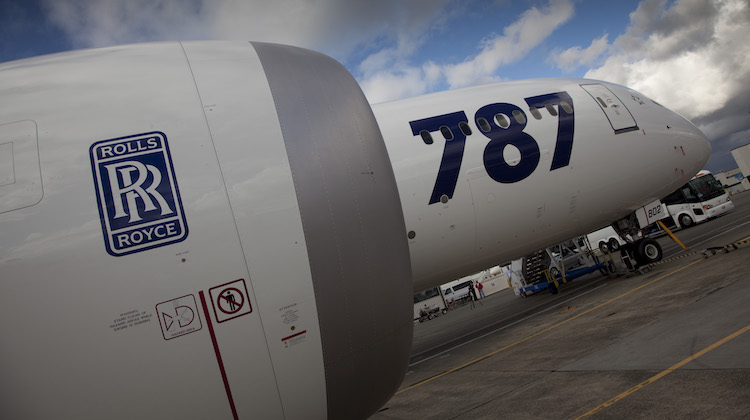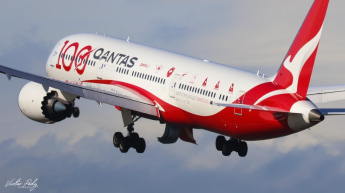
Boeing 787 operators with Rolls-Royce Trent 1000 Package C engines face potential further disruptions to their flight schedules after the engine maker announced the need for further checks due to issues with the powerplant’s turbine blades.
Rolls-Royce said in a statement on April 13 the decision to carry out addition inspections, in addition to those previously planned when the problem first emerged 2016 and again in 2017, was as part of its “ongoing inspection and testing of those engines”.
“The increased inspection frequency is driven by our further understanding of the durability of the Trent 1000 Package C compressor, a condition that we highlighted earlier this year,” Rolls-Royce said.
“These inspections will be supported by service management and flight operations guidance to airlines to be issued by the airworthiness authorities.
“This will unfortunately lead to additional disruption for our customers.”
Rolls-Royce said there were about 380 Trent 1000 Package C engines currently in service, including with Air New Zealand, All Nippon Airways and British Airways.
The European Aviation Safety Agency (EASA) on April 13 updated its previous airworthiness directive (AD) – that was issued in December 2017 – requiring more regular checks on the intermediate pressure compressor rotor blades.
“This condition, if not detected and corrected, could lead to inflight blade release, possibly resulting in reduced control of the aeroplane,” the EASA AD said.
The United States Federal Aviation Administration (FAA) was expected to issue its own AD in the coming days. Media reports suggest the FAA would limit extended operations (ETOPS) rules for affected airlines.
Air New Zealand’s 787-9s have 330-minute ETOPS approval, which means the airline can fly the aircraft on a route that keeps it within five and a half hours flying time on a single engine from an alternate airport in the event of an engine failure.
The New Zealand flag carrier said in a statement on Saturday it had nine engines affected by the issue of engine turbine blades wearing out sooner than expected.
“Last month Rolls-Royce, in conjunction with European regulator EASA, issued a directive requiring operators of a type of Trent 1000 engine known as ‘Package C’ to carry out earlier than usual maintenance checks on a specific part of the engine compressor,” Air New Zealand said.
“This check was already required prior to the engine reaching a flying threshold of 2,000 cycles (one way journeys). The directive reduces that timeframe to 300 cycles.
“Trent 1000 Package C engines that have operated fewer than 300 cycles are unaffected by this directive. Air New Zealand also has Trent 1000 TEN model engines in its 787 fleet and these are unaffected.
Further, Air New Zealand said it expected there would be “some impact to its international schedule as a result of the checks”.
In December, Air New Zealand had two incidents where 787-9 operated flights were forced to turn back due to what was at the time described as “abnormal indications on one of the engines”.
It had wet-leased two aircraft – an Airbus A330 and A340 – from Portuguese operator Hi Fly as cover for having its 787-9s unavailable.
Other airlines apart from Air New Zealand have also been forced to park aircraft while waiting for their Trent 1000 Package C engines to be inspected, repaired and/or replaced amid a shortage of replacement engines.

At its 2017 full year financial results publication in March 2018, Rolls-Royce said the requirement for more regulatory inspections were expected to affect its bottom line to the tune of 370 million pounds.
While there was no update on costs in Rolls-Royce’s statement on Friday, the company said it was “reprioritising various items of discretionary spend to mitigate these incremental cash costs”.
“Our focus is on supporting our customers and doing all we can to minimise any impact on their operations,” Rolls-Royce chief executive Warren East said.
“We sincerely regret the disruption this will cause to our customers and our team of technical experts and service engineers is working around the clock to ensure we return them to full service as soon as possible.
“We will be working closely with Boeing and affected airlines to minimise disruption wherever possible.”
Boeing said it a statement about 25 per cent of the 787 fleet was powered by Rolls-Royce Trent 1000 Package C engines and it was continuing to work with Rolls-Royce, its airline customers and regulators to “fully resolve” what it described as a “known issue”.
“An existing EASA Airworthiness Directive for the Package C engine requires inspections of an intermediate pressure compressor blade at certain flight cycles,” Boeing said.
“If a durability issue is found, the blade will be replaced.
“Boeing is deploying support teams to mitigate service disruption.
“Safety is our highest priority.”















